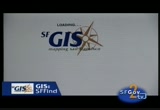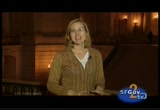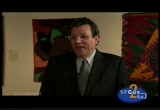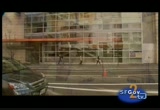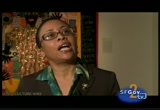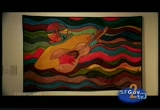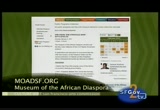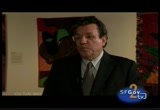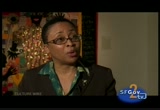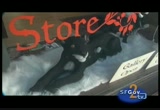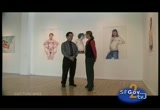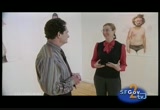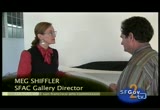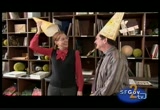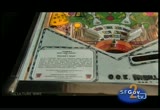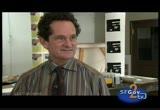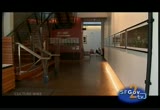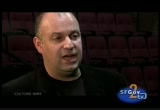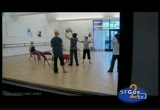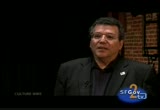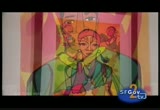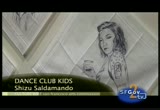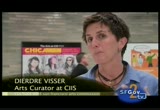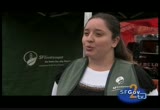tv [untitled] March 30, 2011 12:00pm-12:30pm PDT
12:00 pm
and through the sf applications we support from the mayor's office of neighborhood services. you can drill down in the neighborhood and get where the newest hospital or police or fire station. >> we are positive about gis not only people access it in the office but from home because we use the internet. what we used to do was carry the large maps and it took a long time to find the information. >> it saves the city time and money. you are not taking up the time of a particular employee at the assessor's office. you might be doing things more efficient. >> they have it ready to go and sa this is what i want. >> they are finding the same things happening on the phone
12:01 pm
where people call in and ask, how do i find this information? we say, go to this website and they go and get the information easily. >> a picture tells a thousand stories. some say a map >> welcome to "culturewire." since december 2005, the museum of the african diaspora, known locally,moad, has presented programs that celebrate and explore the culture, history, and art of people with african descent throughout the and added states and throughout the world. the director of cultural affairs recently met with the museum director. to learn more about the current expedition, textural rhythms, constructing the jazz tradition, contemporary african american quilts.
12:02 pm
>> welcome to "culturewire." today, we are at the museum of the african diaspora, which is celebrating its fifth anniversary occupying one of the premier cultural district in the world, the yerba buena cultural arts center in san francisco. joining me is the cultural art director. tell us what moad's mission is. what does it do? >> the museum of the african diaspora showcases the history, art, and cultural richness that resulted from the dispersal of africans throughout the world. we do that through compelling and innovative exhibitions, public programs, and education programs. our goal is to celebrate and present for appreciation to our broad and diverse public the controversial energy
12:03 pm
contributions of people of african descent to world culture in all aspects in all areas, including politics, culture, economics, education, just in all aspects of cultural forms of expression. >> one of the fascinating things since 2005 when the museum was established, is that it has become clear from science that all of humanity originates in africa. how does that influence the education programs or presentation here at moad? >> obviously, being able to attenuate that, and there is a sign at the door that says, "when did you know that you were african?" our point is that we share a common dna, and it connects us on a number of different levels. this institution is an institution available to everyone, a resourced for
12:04 pm
everyone. >> you have both permanent and temporary exhibitions, right? >> we do. our temporary exhibition program is one that we are restructuring. i have been here now for about a year and a few months, and as a former curator, i'm very interested in this aspect of developing the visual arts program. part of what we are looking at is using the four core seems that define our program -- origins, migration and movement, transformation, an adaptation -- as a framework for our thinking about the kinds of exhibits we present. >> we want everybody to come and see the permanent exhibition. there might be a special opportunity to visit with the current show that you currently have, which is constructing the jazz tradition, which is a very striking exhibition of quilts. >> it is a compelling exhibit on a number of different levels. visually, it is compelling. in terms of the subject matter,
12:05 pm
in terms of the approach to materials, it is so rich and diverse. it is a colorful show, a show that is deep in content, and we know something of the history of the "'s tradition within the african-american community. it is a tradition that came from africa, has its roots in africa, but during slavery, this was a combination of things. one was a way to be able to communicate with each other, a way to create beautiful objects, and a way to create functional, utilitarian objects for the family and community. the other part that makes it so interesting is the focus on jazz. there are two attritions being celebrated here. certainly, the tradition as we know it -- these are not traditional quilts. they have their roots in traditional aspects, but what you will find in this exhibition are works that include materials on the surface, new processes, copying, and putting
12:06 pm
photographic images on the surface. you will find packets sewn onto the surface, so the methodology from traditional " making has changed from how traditional quilt makers use the medium. >> our visitors can visit the web site, which we will be showing on the segment, so follow the link to the website, and get all of the latest information about all these events related to this exhibition, and, of course, you guys are very active. throughout the year, with all kinds of special programs. >> yes, we are. this is what i'm so excited about. >> this may take us off track a little bit, but a couple of things i wanted to highlight is that the creation of moad is one of the flagship creations of the
12:07 pm
redevelopment of san francisco. it is housed inside -- what is the building? the regency, right? >> the st. regis museum tower. >> the st. regis museum tower, which is one of the development projects that was promoted by the redevelopment agency is what allows the city to -- and the development agency to give form and establish moad in the yerba buena cultural district. now, we are looking at governor brown oppose a proposal, which means that in the future, it he is successful, they would not have had the rebel the agency to promote these economic and cultural projects. it is something that has relevance today in terms of public policy today, what is going to happen in the future if we do not have a redevelopment agency to promote this development. >> yes. moad is the result or
12:08 pm
culmination of a public/private partnership that included the redevelopment agency and former mayor brown, and included the developer of this area. we had an opportunity to develop, create important cultural components of this public/private partnership. i understand the concern. i'm delighted they are here and will continue to be here and will continue to do the good work we are doing. >> absolutely. thank you so much for being part of "culturewire." >> thank you for having me. >> for more information about the museum of the african the museum of the african diaspora, visit moadsf.org.
12:09 pm
>> i'm your host of "culturewire," and today, here at electric works in san francisco. nice to see you today. thanks for inviting us in and showing us your amazing facility today. >> my pleasure. >> how long has electric works been around? >> electric works has been in san francisco since the beginning of 2007. we moved here from brisbane from our old innovation. we do printmaking, gallery shows, and we have a fabulous retail store where there are lots of fun things to find. >> we will look at all of that as we walk around. it is incredible to me how many different things you do. how is it you identify that san francisco was in need of all these different services? >> it came from stepping out of graduate school in 1972. i wrote a little thing about how this is an idea, how our world
12:10 pm
should work. it should have printmaking, archiving, a gallery. it should have a retail store. in 1972, i wanted to have art sales, point-of-sale at the grocery store. >> so you go through the manifesto. with the bay area should have. you are making art incredibly accessible in so many different ways, so that is a good segue. let's take a walk around the facilities. here we are in your gallery space. can you tell me about the current show? >> the current show is jeff chadsey. he is working on mylar velum, a smooth, beautiful drawing surface. i do not know anyone that draws as well as he does. it is perfect, following the contours and making the shape of
12:11 pm
the body. >> your gallery represents artists from all over, not just the bay area, an artist that work in a lot of different media. how to use some of what you look for in artists you represent? >> it is dependent on people are confident with their materials. that is a really important thing. there is enough stuff in the world already. >> you also have in his current show an artist who makes sculpture out of some really interesting types of materials. let's go over and take a look at that. here we are in a smaller space. project gallery. >> artists used the parameters of this space to find relationships between the work that is not out in the big gallery. >> i noticed a lot of artists doing really site-specific work. >> this is a pile of balloons, something that is so familiar, like a child's balloon.
12:12 pm
in this proportion, suddenly, it becomes something out of a dream. >> or a nightmare. >> may be a nightmare. >> this one over here is even harder to figure out what the initial material is. >> this is made out of puffy paint. often, kids use it to decorate their clothes. she has made all these lines of paint. >> for the pieces we are looking at, is there a core of foam or something in the middle of these pieces that she built on top of? >> i'm not telling. >> ah, a secret. >> this silver is aluminum foil, crumbled of aluminum foil. her aesthetic is very much that quiet, japanese spatial thing that i really admire. their attention to the materiality of the things of the world.
12:13 pm
>> this is a nice juxtaposition you have going on right now. you have a more established artists alongside and emerging artists. is that something important to you as well? >> very important in this space, to have artists who really have not shown much. now let's look at other aspects of electric works operation. let's go to the bookstore. >> ok. >> in all seriousness, here we are in your store. this is the first space you encounter when you come in off the street. it has evolved since you open here into the most amazingly curious selection of things. >> this was the project for the berkeley art museum. it was -- this is from william wiley's retrospective, when he got up onstage to sing a song, 270 people put on the cat.
12:14 pm
>> it is not just a bookstore. it is a store. can you talk us through some of your favorites? >> these are made in china, but they are made out of cattails. >> these pieces of here, you have a whale head and various animals and their health over there, and they are jewelry. >> we do fund raisers for nonprofits, so we are doing a project for the magic theater, so there are some pretty funny cartoons. they are probably not for prime time. >> you sort of have a kind of holistic relationship where you might do merchandise in the store that promotes their work and practice, and also, prince for them. maybe we should go back and look at the print operation now. >> let's go. >> before we go into the print shop, i noticed some incredible items you have talked back here. what are we standing in front
12:15 pm
of? >> this is william wiley, only one earth. this is a print edition. there are only eight total, and what we wanted to do was expand the idea of printmaking. this is really an art object. there we go. >> besides the punball machine, what do you produce in limited edition? >> there is the slot machine. if you win the super jackpot, you have saved the world. >> what about work? >> the right design, it was three volumes with lithographs in each volume. the cab of count dracula with 20 lithographs inside and lined
12:16 pm
with beaver fur. really special. >> let's move on to the print shop. >> ok. the core of what we do is making things. this is an example. this is a print project that will be a fund-raiser for the contemporary music players. we decided to put it in the portfolio so you could either frame at or have it on your bookshelf. >> so nonprofits can come to you, not just visual are nonprofits, but just nonprofits can come to you, and you will produce prints for them to sell, and the profits, they can keep. >> the return on investment is usually four times to 10 times the amount of investment. this is for the bio reserve in mexico, and this is one of the artists we represent. >> you also make prints for the artists that you represent.
12:17 pm
over here are some large prints by a phenomenal artist. >> he writes these beautiful things. anyone who has told you paradise is a book of rules is -- has only appeared through the windows. this is from all over coffee. we are contract printers for all kinds of organizations all across the country. >> thank you very much for showing us around today. i really appreciate you taking the time to let me get better acquainted with the operation and also to share with our "culturewire" team. >> welcome to "culturewire." on this episode, the director of cultural affairs takes us on a field trip to the mission district to check out odc's new
12:18 pm
36,000 square foot campus, the largest in the region. >> for san franciscans, odc has a very significant significance. stands for a venerable performing arts organization celebrating its 40th anniversary of bringing fans and theaters to the bay area. standing with me today on "culturewire" is the theater director of odc. thank you for joining us. i mention that this is the 40th anniversary. >> it is indeed. >> i'm standing with you in a fabulous theater that was completed six months ago in time for this anniversary. tell me about how it has been going for the last six months. >> absolutely.
12:19 pm
in terms of the anniversary, the dance company, which is our founding body, is celebrating its 40th anniversary, and it is the 30th anniversary, so it is historic for both sides, and the completion of the theater represents in some ways the completion of our entire campus that began in 2005. it has come to its fruition with the completion of the theater. the theater opening was remarkable. one of the things we wanted to do was to make sure that our community really truly -- our san francisco bay area community understood that this theater was for them. we invited 31 bay area companies to do a day-long performance marathon, so we really launched with a feeling of this is for everyone in this community. it was a tremendous thing to bring everyone together around the opening of this building. >> you are part of our creative
12:20 pm
troika, including the founder, brenda wey and k.t. nelson. talk about what it is like to keep this campus going. >> it is a wonderful thing to be working with someone who is certainly your co-worker and also largely your mentor. i inherited the theater at a funny time in its life. it needed to make some decisions as an institution about what it wanted to be. whether it wanted to be exclusively a rental facility, it is needed to be a rehearsal space with a really high ceilings -- whatever it was, having that level of leadership that my founding director is also my boss really made that possible. i really felt like i had great stewardship and we were able to make really innovative decisions for how the theater could grow over the decade. >> living with -- living with someone who is both your
12:21 pm
immediate boss and also a working artist is also a huge asset. that is one of the things that keeps the creativity flowing through odc. it is a campus about the creative process at all times. >> the theater was part of a second phase of capital fund raising and community support. the previous one had renovated the space where the rehearsal studios are and the school is, sell what does that sort of say about the importance of the odc in the community? >> i think it's spoke to the two very different tracks of our organization. part of what we do is education and outreach. part of what we do is performance on the part of our company, odc dance, and a third part of what we do is this presenting an incubation stage. when we came to people to talk about the theater as a second investment after having built the dance commons, the distinct
12:22 pm
purpose of the theater really came through. what we were going to do with our venue was invest deeply in creativity, deeply in our regional artists, and we were going to do something that most mid-size san francisco venues have struggled to do. >> talk to me a little about the group other than odc that have used this space. >> one of the great pleasures in our opening season was to go back and invite two of our former resident artists to launch this space. arab laung was to invite two of the best known -- our launch was to invite two of the best known companies in the city to share in the event, and it was really exceptional. these are companies that i have worked with and the organization has worked with releases they were either newborn or just a few years old, and to go back to
12:23 pm
that roster and invite two of our really major home town honeys to open a theater and be able to treat them as the professionals they have become with this opportunity, with this menu, and with the resources that were available was really a full circle experience for both of us. >> now that the theater has been fully renovated, where is it going? >> i believe that san francisco is in some ways to the nation what odc is to san francisco, which is to say that i believe the west coast is the hotbed for innovation. i think it is where major cultural innovations happen, where huge ideas are born and often raised up. it may not often be the marketplace that other major metropolitan areas are, but i do think is the center of where creativity sits. i think that what odc can do by becoming this level of
12:24 pm
institution is raise the platform of san francisco. i name -- in many ways, it is sort of a death process, but putting an artist in contact with recording artists, with other major areas, with exchange companies around the country and the world will become a central part of what we do. >> it is clear that now there is a campus that has been built out and filled in, that odc is playing this fabulous supportive and incubated role, both for san francisco, the bay area, and the country. thank you so much for being part of "culturewire." >> my pleasure. >> and for contributing so much to the performing arts of our city. >> for more information, visit odc >> welcome to "culture wire."
12:25 pm
on this episode, we explore what it means to the aged, in today's society -- what it means to be chicana in today's society. chica chic features an array of artwork by five leading chicana artists that addresses a range of issues such as integration, sustainability, and integration. using a distinct visual approach, each of the artist's response to the shifting needs of their communities in ways that offer unique perspectives and multiple points of entry. >> the exhibition is to bring together the voices of a new generation chicana artists, all of whom reference the works of the civil-rights movement in their works, but they are also
12:26 pm
responding to a new cultural concerns and new cultural circumstances. >> the works in the show include a large canvas depicting a woman washing the beach with her hair at the u.s./mexican border. the painting encourages the viewer to engage with the current debates over immigration and the politics of women and labor. influenced by the campaigns of the chicano civil rights movement, this oakland artist is a print maker whose work has helped and sustainability with the immigrant community as well as other current sociopolitical issues. this print-based work draws on appropriated agricultural worker manuals and high fashion labels to satirically address class issues, cultural identities, and consumerism. >> angelica -- her father was an
12:27 pm
agricultural worker, so she has drawn a lot from the materials the agricultural department sends to agricultural workers, referencing the depiction of farm workers and some of the information about pesticide application. >> mitzi combines a variety of media, including embroidery, to create artifacts of mexican, chicano, pop culture. she greets immensely detailed drawings of celebrities on the same platform of her friends and families. her work combines elements of chicano portraiture and low writer art, rendered in upon new art style, or intricate drawings on handkerchiefs, also -- often associated with prison art. her portrait of three girls is among several of original posters by the exhibition artists, which are on view at various bart stations as part of a public campaign funded by the
12:28 pm
national endowment of the arts. from the outset, the curator felt it was important for the exhibition to have a public art components of the work could reach the widest possible audience. more than just a promotion, the posters connect the work of these powerful artists with new audiences, including the vital chicano and latino community. images can be found in bart stations located in san for cisco and oakland. >> it is enormously exciting for me personally and for the institution. the poster with up right after new year's, and i remember very vividly -- i am a regular rider, and i went into the station and saw the first poster i had seen, it was incredibly exciting. it is satisfying to know that through the campaign, we are reaching a broader audience. >> for more information about
12:29 pm
>> i work with the department of environment and we are recycling oil. thank you. we can go into a refinery and we can use it again. they do oil changes and sell it anyway, so now they know when a ticket to a. hal>> to you have something you want to get rid of? >> why throw it away when you can reuse it? >> it can be filtered
232 Views
IN COLLECTIONS
SFGTV2: San Francisco Government Television Television Archive
Television Archive  Television Archive News Search Service
Television Archive News Search Service 
Uploaded by TV Archive on

 Live Music Archive
Live Music Archive Librivox Free Audio
Librivox Free Audio Metropolitan Museum
Metropolitan Museum Cleveland Museum of Art
Cleveland Museum of Art Internet Arcade
Internet Arcade Console Living Room
Console Living Room Books to Borrow
Books to Borrow Open Library
Open Library TV News
TV News Understanding 9/11
Understanding 9/11